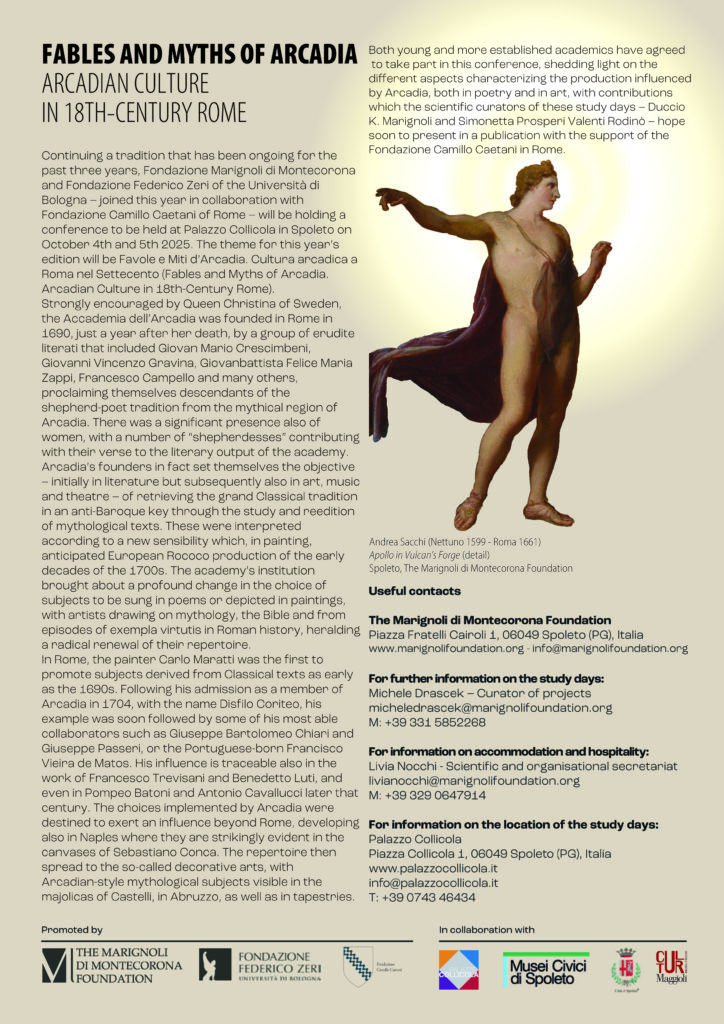Continuing a tradition that has been ongoing for the past three years, Fondazione Marignoli di Montecorona and Fondazione Federico Zeri of the Università di Bologna – joined this year in collaboration with Fondazione Camillo Caetani of Rome – will be holding a conference to be held at Palazzo Collicola in Spoleto on October 4th and 5th 2025. The theme for this year’s edition will be Favole e Miti d’Arcadia. Cultura arcadica a Roma nel Settecento (Fables and Myths of Arcadia. Arcadian Culture in 18th-Century Rome).
Strongly encouraged by Queen Christina of Sweden, the Accademia dell’Arcadia was founded in Rome in 1690, just a year after her death, by a group of erudite literati that included Giovan Mario Crescimbeni, Giovanni Vincenzo Gravina, Giovanbattista Felice Maria Zappi, Francesco Campello and many others, proclaiming themselves descendants of the shepherd-poet tradition from the mythical region of Arcadia. There was a significant presence also of women, with a number of “shepherdesses” contributing with their verse to the literary output of the academy.
Arcadia’s founders in fact set themselves the objective – initially in literature but subsequently also in art, music and theatre – of retrieving the grand Classical tradition in an anti-Baroque key through the study and reedition of mythological texts. These were interpreted according to a new sensibility which, in painting, anticipated European Rococo production of the early decades of the 1700s.
The academy’s institution brought about a profound change in the choice of subjects to be sung in poems or depicted in paintings, with artists drawing on mythology, the Bible and from episodes of exempla virtutis in Roman history, heralding a radical renewal of their repertoire.
In Rome, the painter Carlo Maratti was the first to promote subjects derived from Classical texts as early as the 1690s. Following his admission as a member of Arcadia in 1704, with the name Disfilo Coriteo, his example was soon followed by some of his most able collaborators such as Giuseppe Bartolomeo Chiari and Giuseppe Passeri, or the Portuguese-born Francisco Vieira de Matos. His influence is traceable also in the work of Francesco Trevisani and Benedetto Luti, and even in Pompeo Batoni and Antonio Cavallucci later that century. The choices implemented by Arcadia were destined to exert an influence beyond Rome, developing also in Naples where they are strikingly evident in the canvases of Sebastiano Conca. The repertoire then spread to the so-called decorative arts, with Arcadian-style mythological subjects visible in the majolicas of Castelli, in Abruzzo, as well as in tapestries.
Both young and more established academics have agreed to take part in this conference, shedding light on the different aspects characterizing the production influenced by Arcadia, both in poetry and in art, with contributions which the scientific curators of these study days – Duccio K. Marignoli and Simonetta Prosperi Valenti Rodinò – hope soon to present in a publication with the support of the Fondazione Camillo Caetani in Rome.
YouTube live stream:

